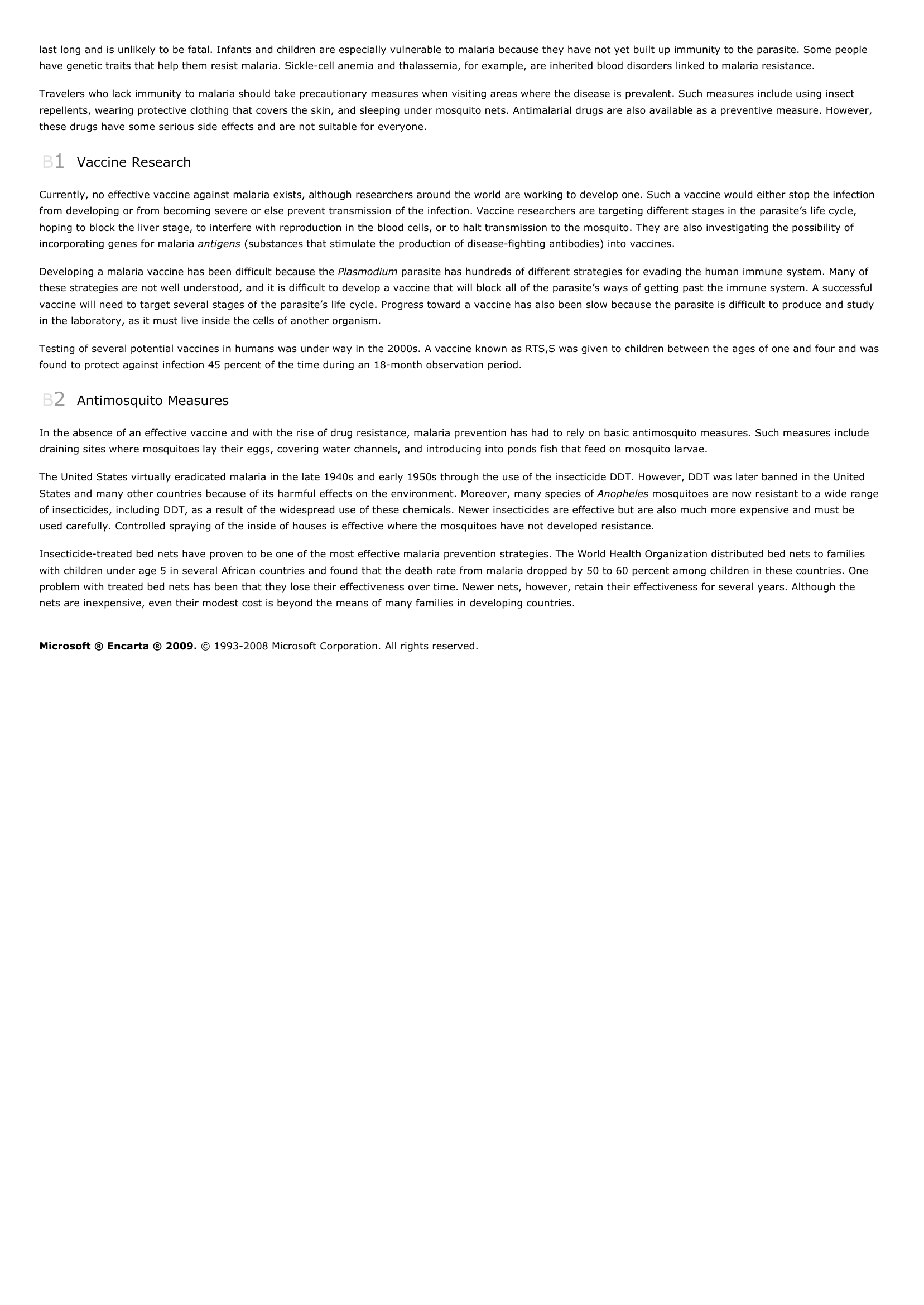Malaria.
Publié le 11/05/2013

Extrait du document
«
last long and is unlikely to be fatal.
Infants and children are especially vulnerable to malaria because they have not yet built up immunity to the parasite.
Some peoplehave genetic traits that help them resist malaria.
Sickle-cell anemia and thalassemia, for example, are inherited blood disorders linked to malaria resistance.
Travelers who lack immunity to malaria should take precautionary measures when visiting areas where the disease is prevalent.
Such measures include using insectrepellents, wearing protective clothing that covers the skin, and sleeping under mosquito nets.
Antimalarial drugs are also available as a preventive measure.
However,these drugs have some serious side effects and are not suitable for everyone.
B1 Vaccine Research
Currently, no effective vaccine against malaria exists, although researchers around the world are working to develop one.
Such a vaccine would either stop the infectionfrom developing or from becoming severe or else prevent transmission of the infection.
Vaccine researchers are targeting different stages in the parasite’s life cycle,hoping to block the liver stage, to interfere with reproduction in the blood cells, or to halt transmission to the mosquito.
They are also investigating the possibility ofincorporating genes for malaria antigens (substances that stimulate the production of disease-fighting antibodies) into vaccines.
Developing a malaria vaccine has been difficult because the Plasmodium parasite has hundreds of different strategies for evading the human immune system.
Many of these strategies are not well understood, and it is difficult to develop a vaccine that will block all of the parasite’s ways of getting past the immune system.
A successfulvaccine will need to target several stages of the parasite’s life cycle.
Progress toward a vaccine has also been slow because the parasite is difficult to produce and studyin the laboratory, as it must live inside the cells of another organism.
Testing of several potential vaccines in humans was under way in the 2000s.
A vaccine known as RTS,S was given to children between the ages of one and four and wasfound to protect against infection 45 percent of the time during an 18-month observation period.
B2 Antimosquito Measures
In the absence of an effective vaccine and with the rise of drug resistance, malaria prevention has had to rely on basic antimosquito measures.
Such measures includedraining sites where mosquitoes lay their eggs, covering water channels, and introducing into ponds fish that feed on mosquito larvae.
The United States virtually eradicated malaria in the late 1940s and early 1950s through the use of the insecticide DDT.
However, DDT was later banned in the UnitedStates and many other countries because of its harmful effects on the environment.
Moreover, many species of Anopheles mosquitoes are now resistant to a wide range of insecticides, including DDT, as a result of the widespread use of these chemicals.
Newer insecticides are effective but are also much more expensive and must beused carefully.
Controlled spraying of the inside of houses is effective where the mosquitoes have not developed resistance.
Insecticide-treated bed nets have proven to be one of the most effective malaria prevention strategies.
The World Health Organization distributed bed nets to familieswith children under age 5 in several African countries and found that the death rate from malaria dropped by 50 to 60 percent among children in these countries.
Oneproblem with treated bed nets has been that they lose their effectiveness over time.
Newer nets, however, retain their effectiveness for several years.
Although thenets are inexpensive, even their modest cost is beyond the means of many families in developing countries.
Microsoft ® Encarta ® 2009. © 1993-2008 Microsoft Corporation.
All rights reserved..
»
↓↓↓ APERÇU DU DOCUMENT ↓↓↓

































